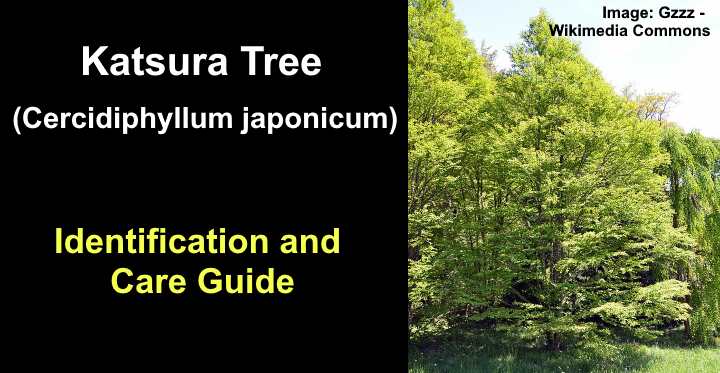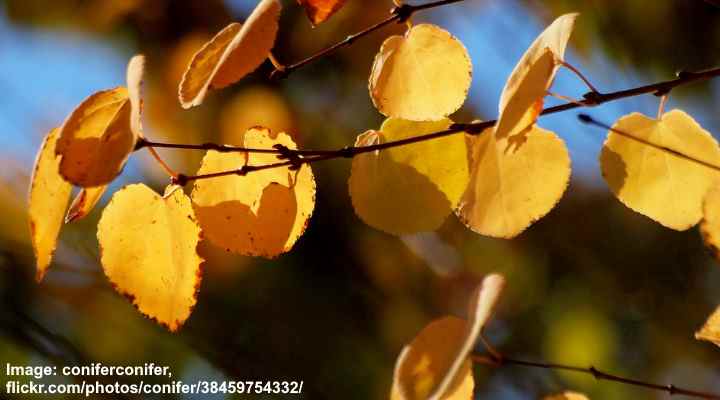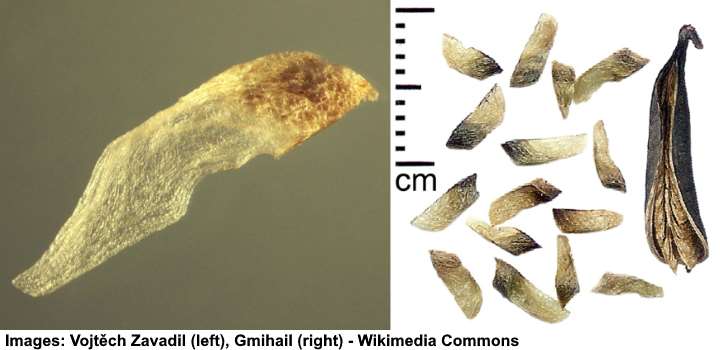Katsura Tree (Including Weeping Katsura): Leaves, Bark and Care (Pictures) – Identification

Katsura tree is a medium-sized ornamental flowering tree with light brown shaggy bark, heart-shaped green leaves, and spectacular golden-yellow or orange fall foliage. A fascinating feature of the katsura tree is its sweet caramel-like smell when the leaves drop in the fall. The multi-trunked deciduous tree grows an oval to a pyramidal crown with arching branches.
Katsura trees grow to an average height of 50 ft. (15 m) tall and they have a medium growth rate.
The weeping katsura tree has a short growth height of 20 ft. (6 m). It can be a stunning addition to a garden landscape, with its cascading branches of lush green foliage, red fall color.
This article is an identification guide to the ornamental katsura tree. Descriptions and pictures of the decorative tree’s leaves, bark, flowers, and seeds will help identify this tree in a landscape. Additionally, you will get helpful tips on growing a katsura tree in your garden.
Katsura Tree (Cercidiphyllum japonicum) Facts

Katsura trees have multiple stems but can be grown as a single-stemmed trees
The katsura tree is a beautiful deciduous tree in the genus Cercidiphyllum and native to Japan and China. Katsura trees have a medium growth rate and mature at a height of 40 to 60 ft. (12 – 18 m) tall and a trunk up to 6.5 ft. (2 m) in diameter.
Katsura trees are identified by their attractive arching growth habit, forming a spreading, pyramidal, rounded crown. The tree’s foliage is usually a green color but can show hints of purple, red, or burgundy colors. The attractive obovate or heart-shaped leaves have a wavy edge and pointed apex.
The katsura tree thrives in USDA zones 4 through 8 and performs best in full sun to partial sun in moist, well-drained soil. Some protection from the afternoon sun is preferred in hot, sunny climates.
Katsura trees are relatively pest and disease-resistant and can live for hundreds of years.
The smell of katsura tree leaves is one of the fascinating features of this deciduous, multi-trunked tree. The katsura tree is also called the caramel tree due to the burnt sugar and cinnamon smells that the orange-yellow fall leaves emit. Some people describe the aroma of katsura tree foliage as cotton candy.
The katsura tree has a year-long visual appeal as a spectacular shade tree. Green leaves appear in spring after tiny greenish or reddish flowers have bloomed. The tree’s spreading canopy provides shade in summer before turning orange-yellow in the fall. Even without leaves, the katsura tree has an attractive pyramidal silhouette.

Katsura trees in autumn
Weeping Katsura Tree (Cercidiphyllum japonicum ‘Pendulum’)

Weeping katsura tree (Cercidiphyllum japonicum ‘Pendulum’)
The weeping katsura tree is a Cercidiphyllum japonicum cultivar with pendulous branches that droop almost horizontally downward. The fast-growing small to medium-sized tree has a distinct weeping shape. Like the species tree, a weeping katsura tree has stunning orange-yellow or reddish-brown fall colors. The droopy tree grows up to 20 ft. (6 m) tall and 15 ft. (4.5 m) wide.
Katsura Tree Bark

Bark of a mature katsura tree
The bark on the katsura tree is identified by its light brown or gray color and scaly appearance. Typically, bark on immature katsura trees is smooth with horizontal etches. The bark becomes scalier and peels in thin strips as the tree matures. Mature bark on katsura trees looks distinctly shaggy and rough.
Katsura Tree Leaves

Katsura tree leaves
Leaves growing on katsura tree branches are cordate or ovate (heart-shaped) with a toothed or scalloped margin. The disc-like leaves are a green color with shades of red and purple during spring. Before dropping in the fall, katsura foliage turns an impressive golden-yellow color and emits a sugary, caramel aroma.

Katsura leaves in autumn
Katsura leaves grow in pairs, oppositely on short petioles. The rounded leaves with the tapered apex measure 2” to 4” (5 – 10 cm) across. New katsura leaves emerge in a reddish to purple shade in spring, turn green in summer, and then orangey-yellow in the fall.
Katsura Tree Flowers

Katsura flowers: female (left) and male (right)
Flowers blooming on the katsura tree in spring are inconspicuous tiny pink-reddish blossoms. Katsura trees are dioecious trees — meaning there are separate male and female trees. Katsura tree flowers on female trees are small and have tentacles to catch pollen. On the other hand, male katsura tree flowers have pollen sacks hanging out. The trees have a short blooming time.
Katsura Tree Fruit (Seeds)

Katsura splitting mature fruit
Seeds appear on katsura trees in the fall. The katsura tree “fruit” is tiny seeds in a pod-like structure. The fruit grows in clusters of pods containing numerous winged seeds. The mature pods split open in fall through winter, and the wind carries the tiny seeds far from the parent tree.

Katsura seeds
Katsura Tree Identification
Katsura trees are identified by their heart-shaped finely serrated dark green leaves growing on slender reddish-brown twigs with pinkish-red flower buds. The deciduous, multi-trunk tree also has recognizable grayish-brown bark that peels in thin strips. In a landscape, katsura trees have a distinctive spreading pyramidal crown growing up to 60 ft. (18 m) tall.
Katsura Trees in the Landscape
Katsura trees are suitable shade specimen trees for large landscapes. The medium-sized trees have multiple stems, making them ideal for screening. Growing around 50 ft. (15 m) tall and spreading canopy up to 35 ft. (10.5 m) wide, it’s vital to ensure you’ve enough room to grow the tree.
In smaller landscapes, a weeping katsura tree is a better option. Not only do the pendulous, cascading branches look spectacular sweeping the ground, but the weeping katsura is more compact and doesn’t grow as tall.
Where to Plant Katsura Tree
Plant a katsura tree in a sunny spot in the landscape with fertile soil and a sheltered area protected from strong winds. Katsura trees also have a shallow root system; therefore, you should leave a space of about 20 to 30 ft. (6 – 10 m) from buildings, driveways, or structures.
Due to their shallow roots, katsura trees are not drought tolerant. Also, in the hottest areas of its growing range, a katsura tree needs to be planted in a location with some partial shade. In addition, it needs plenty of water during the hottest months. Therefore, choose a sheltered spot with soil that retains moisture.
Another consideration about where to plant a katsura tree is the soil type. Neutral to acidic soil will ensure the best fall colors. And despite being a cold-hardy tree, it doesn’t perform well in hard frosts.
How to Plant Katsura Tree
The best time to plant a nursery katsura tree is in the fall during dormancy. First, dig a hole twice as wide as its root ball and no deeper than it was planted in the container. Set the root ball, so the soil line on the stem matches the soil level. Then backfill the hole with native soil, pressing down around the roots to remove air pockets.
After planting the katsura tree, thoroughly water it to help the roots get established and remove remaining air pockets. Then put a 4-inch (10 cm) layer of mulch over the root area to improve moisture retention and prevent weed growth.
It’s good to remember that digging a hole too deep can encourage root rot and other diseases.
After planting the tree, stake it to support the tree for the first two years until the roots are established.
How to Grow Katsura Tree From Seed

Katsura seedlings
It is easy to grow a katsura tree from seed. Katsura seeds mature on the tree and are ready in the fall for planting. In moderately warm climates (in USDA growing zones 7 and 8), you can plant the seeds directly in the ground or in a small pot. In colder climates, wait until spring before planting the seeds.
After collecting katsura seeds, store them in a paper envelope and put them in a dark, dry place to allow them to dry out. Around February or March, soak the seeds for 24 hours and discard any that float. Then wrap in a moist cloth and place in the refrigerator for seven days. After that, plant the seeds in individual pots containing moist peat moss.
It takes eight to 12 days for seeds to germinate. First, put the pots in a bright spot, protected from direct sunlight, and cover them with plastic. After katsura seedlings appear, remove the plastic and keep the soil moist. In four to six weeks, the seedlings can be transferred to the ground if the threat of frost has passed.
Katsura Tree Care Guide
Katsura is a low-maintenance ornamental tree that thrives in most conditions. However, there are a few requirements to ensure the tree grows well. Katsura trees perform best with plenty of water when planted in well-drained, organically-rich fertile soil.
Here are some handy tips on caring for a katsura tree in your landscape.
How to Water Katsura Tree
A katsura tree has high water requirements, and you should give the tree about 1” (2.5 cm) of water per week for the first two years. For best growth, the soil should be consistently moist without being waterlogged. An established katsura tree is more drought-tolerant and requires less watering.
For the first two years, a thick layer of mulch is vital to keep the ground moist. Make sure the mulch extends to the tree’s drip line.
Water the tree at the base of the trunk and evenly over the root area until the soil becomes saturated. Although tolerant of drought, a katsura tree needs extra watering in hot, dry places to perform well. Therefore, you may have to water the tree once a week when less than 1” (2.5 cm) of rain falls per week.
Katsura Tree Fertilization
The katsura tree grows best in fertile soil with high nutrient and organic matter content. The ornamental tree also benefits from annual fertilization with a balanced tree fertilizer. The best type of fertilizer for a katsura tree should have an NPK rating of 10-10-10. It’s usually best to apply a slow-release, granular fertilizer every spring to encourage healthy growth.
If using a water-soluble fertilizer, it’s best to apply it three or four times a year, from late April through July. During fall and winter, hold off fertilizing and reduce watering as the tree enters dormancy.
In addition to regular fertilization, a katsura tree benefits from organic compost. As part of your regular tree care, work in a reasonable amount of rotten manure or another type of compost to the root area.
How to Prune Katsura Tree
Regularly pruning a katsura tree when it’s young is essential to encourage good shape and healthy growth. In winter or early spring, remove branches that are crossing, growing toward the trunk, or rubbing against other branches. You can also prune lower branches to allow clearance when the tree matures.
The best way to prune a katsura tree is to remove one or two branches every year for the first few years. After the tree is established, some maintenance pruning every three to five years is sufficient. Chop off dead, decaying, or diseased branches to encourage good health.
Katsura trees have multiple stems, so if you want to grow a single-stemmed tree, you should remove some of the weaker stems emerging from the ground to help develop a strong central trunk.
Katsura Tree Propagation
The best way to propagate a katsura tree is by softwood cuttings in late spring or early summer. Look for branches with new growth and cut a 6” to 8” (10 to 15 cm) length of the stem. The twig cutting should have between four and eight leaf nodes. Remove all leaves apart from the last few at the top.
Next, fill a nursery pot with a moist potting soil mix. Then dip the cut end of the cutting in rooting hormone and place it in the soil so that at least two nodes are covered. Lastly, press down around the stem to secure the cutting.
To help the cutting take root, water the potting soil thoroughly, put a clear plastic bag over it, and seal with an elastic band. Put the cutting in a bright spot but protected from direct sunlight. It should take between four and six weeks for the cutting to root. The rooted katsura cutting can be transferred to the ground in late summer or early fall, well before the risk of frost.
Pests Affecting Katsura Tree Growth
Katsura trees are relatively hardy against pest infestations. In addition, the attractive ornamental tree thrives in most climates and is drought-tolerant when established.
Diseases Affecting Katsura Tree Growth
Katsura trees can suffer from environmental plant damage. The tree has relatively brittle wood that can easily break in strong winds. Additionally, the tree can suffer from heat or sun damage if it doesn’t get enough moisture. Here are a few signs that a katsura tree is suffering from stress.
Yellowing katsura leaves that turn brown are typically a sign of exposure to too much sunshine, high winds, or dry conditions. This may cause the leaves to fall prematurely. If the katsura tree is already mature, you should provide it with regular watering during summer and add a thick layer of mulch over the root area.
Sudden tree wilt tends to affect katsura trees that suffer from overwatering or waterlogged ground. Soggy soil can cause fungal or mold infections to cause leaves to turn brown, wilt, and drop early suddenly. The best course of action is to hold off watering or increase drainage around the tree’s root area.
Split tree bark on a katsura tree can occur from strong winds, temperature fluctuations, or excessive fertilizer. To help improve the tree’s health, trim off dead bark without harming healthy bark. Also, it’s crucial to ensure the roots are well hydrated while avoiding soil becoming too soggy.
Related articles:
- Small or Dwarf Weeping Trees for Landscaping
- Japanese Maple Trees – Identification
- Orchid Tree (Bauhinia): Types and Care
